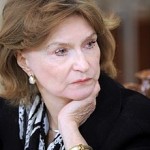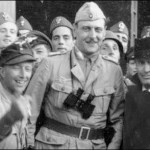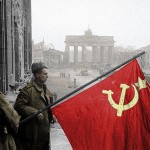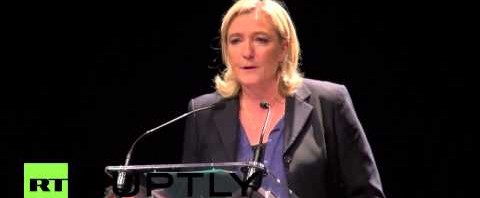Editors’ note: this article has also been published on Stephen Shenfield’s blog.

On January 7, 2015, I was watching the TV channel Rossiya-24. They were talking about the terrorist act that had just taken place at the editorial office of the French satirical weekly Charlie Hebdo. They were broadcasting the first interviews with famous people, who were giving their interpretation of the tragedy and its causes.
So who were those people who first explained to Russians what had happened? Jean-Marie Le Pen, former leader of the French National Front, and Natalia Narochnitskaya, a Russian nationalist politician. Narochnitskaya went on about the “threat” to Christian Europe posed by Muslim immigrants and praised the anti-Muslim demonstrations organized in Germany by the PEGIDA movement. It is futile to call these demonstrators fascists, she said; they are no fascists…
Let me remind you: this is the very movement whose leader Lutz Bachman likes to take photos of himself with an Adolf Hitler forelock and moustache and post them on the internet – a man who is being dragged through the courts not only for inciting interethnic hatred, at which he is a past master, but also for publicly displaying those photos.
Since 2013 Le Pen, Sr. and his daughter Marine, successor to her father as party leader, have often appeared on Russian TV. Especially since 2014 they have received constant publicity, both as personalities and as representatives of the National Front. Over the past year Marine Le Pen has never been far away from our TV screens.

For many years the National Front had very close and friendly relations with the Ukrainian fascist party Svoboda (“Freedom”). This party was founded in 1991 under the name “Social-National Party of Ukraine” (SNPU). At that time they were proud to call themselves Nazis, simply reversing the order of the two words in the traditional “national-socialist” label. The party’s name was changed to Svoboda in 2004 in a quest for greater respectability.
The Svoboda website displays a curious selection of party documents reflecting various stages in the friendship between the French and Ukrainian neo-fascists. Their paths diverged in autumn 2013, when Svoboda was one of the organizers of the Maidan uprising. After Yanukovych was ousted a number of its people (starting with Andrei Parubii, a founding father of the SNPU and commandant of the Maidan) filled top posts in the Ukrainian state apparatus. Meanwhile, the French National Front suddenly took Russia’s side and supported the annexation of Crimea.

In March 2014, I saw on the Svoboda website a number of letters and appeals from the party leadership to the leaders of the National Front and some other European neo-fascist organizations that had likewise taken Russia’s side. A most amusing correspondence in a plaintive tone: “Why are you abandoning us? Don’t be friends with the Kremlin, be friends with us!” And yet the reorientation of the National Front toward Russia has had no impact on the rest of their politics; they remain neo-fascists.
The National Front has paid no heed to the entreaties of their former party comrades in Ukraine. They prefer the junta in Moscow to the junta in Kiev. And in turn the Kremlin junta has joyfully embraced the French Nazis.
Official propaganda is now contradictory to an astonishing degree. It tells us that Russia is fighting a fascist plague that comes from the West and has infected Ukraine. And yet at the same time it sings the praises of those Western fascists who only yesterday were the friends of the Ukrainian fascists. It rejoices at each electoral success of the National Front in France; Russian TV (especially Rossiya-24) hails even their smallest advances in municipal elections as glorious triumphs.
Evidently, for the Kremlin junta only a fascist who is against Russia can be called a fascist. Those fascists who declare their friendship for Russia do not count as fascists at all.
And indeed: how can the term “fascist” be applied to the organizations that gathered in St. Petersburg on March 22 for the “Conservative Forum” when the forum was hosted by the Rodina (Homeland) party? After all, one of the founding fathers of Rodina is none other than current Deputy Prime Minister Dmitrii Rogozin, who among other leading posts oversees the military-industrial complex.
Several European neo-Nazi parties were represented at the forum, including the Greek Golden Dawn, which murders its political opponents (i.e., it is a terrorist organization), the Party of Swedes (it originally called itself the National-Socialist Front, but like the SNPU decided to rebrand itself), and the Spanish and German National-Democratic Parties. For some reason these friends of Russia turned out to be 100% political twins of the Banderite Svoboda and Right Sector. According to a report broadcast on Radio Biznes FM on the morning of March 23, even Le Pen’s National Front was embarrassed to appear in such openly Nazi company and in order to preserve its respectable image sent no representatives to the Conservative Forum.
Many West European neo-Nazis call themselves “national-democrats.” This tradition, which some Russian neo-Nazis have borrowed, originates in Germany, where a small regional organization was formed in the immediate postwar period under the name of the National-Democratic Party of Hessen. When one reads about this party and other neo-Nazi organizations of that period, one is astonished at how similar they were to Ukrainian and Russian extreme right groups of the post-Soviet period:
One of the first extreme right parties to appear in West Germany was the German Right Party, created as early as 1946. It was headed by old Nazis… In 1947 the German Right Party merged with the Conservative Party…
Soon a split took place in the party. In 1949 one of its leaders, Dorls, together with a former major general in Hitler’s army, Roemer, and the old Nazi Kruger, created the Socialist Imperial Party, whose action program was openly neo-Nazi in character… A ruling to prohibit this party was issued in October 1952 and its members went over to other organizations that more cunningly concealed their neo-Nazi character.
One such party was the German Imperial Party, which absorbed some of the members of the German Right Party… They merged with the so-called National-Democratic Party of Hessen to form a new party… While in terms of domestic policy the German Imperial Party differed little from the governing CDU/CSU parties (the governing party in Germany today), in their foreign policy slogans the neo-Nazis advocated open revanchism and a policy of annexations (History of Fascism in Western Europe (in Russian), Moscow 1978, pp. 503—504).
Observe how easily these blocs and alliances of postwar German neo-Nazis brought together organizations whose names included the words imperial, democratic, right, socialist, and conservative. Observe how easily “democrats” morphed into “imperialists” and “conservatives” into “socialists.” What was then already characteristic of one of the segments of the German political spectrum – namely, the extreme right – is now characteristic of practically the whole political spectrum (with isolated and microscopic exceptions) in Russia and Ukraine, where practically any “leftist” you may care to choose is allied not just with rightists but with extreme rightists, where “democrats” have no qualms about joint action with rank authoritarians, where “socialists” and even “communists” are happy to collaborate with imperialist or ethnocratic ultra-rightists. I analyze why this is so and what follows from this in my forthcoming book Contemporary Fascism in Russia and Ukraine.
But let us return to the German national-democrats. In 1964 the German Imperial Party, the German Party, and the Pan-German Party merged to form the National-Democratic Party of Germany.
The neo-Nazis openly sought to rehabilitate the crimes of the fascist regime. They demanded that the prosecution of war criminals be halted and that Germany be freed of the responsibility for starting World War Two. “The glorious and courageous conduct of German soldiers of all times must serve as an example for the Bundeswehr. For so long as the fathers are openly branded as criminals the sons will not be able to become good soldiers” – said the manifesto adopted at the founding congress (History of Fascism in Western Europe, p. 505).
And it is these dear people – people who demand restoration of the “Great German Reich” – who get invited to a forum in Russia by a party whose founder is in the government, busy organizing the rearmament of the Russian armed forces. And at the same time all our mass media are full of hosannas to the great feat of the Soviet soldiers and toilers who defeated German Nazism. So with one hand the Kremlin loudly thanks our grandfathers for crushing Nazism, while with the other hand it pulls those Nazis who somehow escaped our grandfathers’ clutches out of the political dung heap and welcomes them to Russia.
In World War Two the Nazis never managed to take Leningrad, but now our rulers invite them to that very city, settle them in a luxury hotel, and treat them with all honor and respect. Then they have the gall to tell us that they are confronting Hitler’s heirs in Kiev and lecture us on the need to fight against extremism and terrorism.
Such are the paradoxes of patriotism.
Dmitrii Rogozin is one of the rulers of today’s Russia. I am leafing through a collection of old newspapers. Za Rodinu! (“For the Homeland”) was the organ of the Moscow City Branch of the Rodina party. The issue dated November 24, 2005 came out when Rogozin was chairman of that party, during a campaign for elections to the Moscow City Council. This was just after the scandal provoked by Rogozin’s demand that Moscow be cleared of “trash,” by which he very clearly meant migrant workers from the Central Asian republics.
The very first page of the issue features a defense of this statement of Rogozin’s. Use is made of the favorite alibi of all those European neo-Nazis who try to prove that they respect the criminal code – the claim that “we are against only illegal immigration, we are only upholding the law.” They also present themselves as defenders of “traditional values” against “erosion of the true cultural identity of our nation” – a fog of words to hide the fact that essentially they are urging ethnic Russians to beat up the “aliens” as they did in Kondopoga and Biryulevo.
Over half of this issue of the paper is devoted to the theme of illegal immigration. On page 3, Narochnitskaya also has her say on this topic, wholly in line with the orientation of the paper. If now she defends the German neo-Nazis from PEGIDA, that is because she shares the same principles. Alexei Mitrofanov has said that Narochnitskaya writes Putin’s programmatic articles (on February 9, 2012, on the program Open Studio, broadcast on the Fifth, i.e., St. Petersburg, Channel). I wonder if he is right.
In the late 1990s Narochnitskaya’s articles appeared in the magazine National Interests, published by the Institute for a National Reform Strategy. The director of this institute, Baburin, brought together on the editorial board of the journal such prominent Russian nationalists as Shafarevich, Zinoviev, Panarin, Glazyev, and Zatulin. One of her articles appeared in the second issue of the journal in 1999, and alongside it articles by the outright fascists Kozhinov and Kondratenko.
In the same issue we find an article by a certain Vasilyev, entitled “General De Gaulle and the Collapse of the French Empire.” The author not only pays tribute to the myth of the Masonic conspiracy but praises the Vichy regime that collaborated with the Nazis. Let me emphasize this point: an article that praises the humanism and lofty spirituality of allies of the Nazis appeared in a journal published by fervent Russian and Soviet patriots – the same people who constantly glorify the Soviet victory over Germany and its allies in 1945.
As we see, it is no coincidence that the Kremlin should have made friends with the French National Front: the Russian fascists have for many years been demonstrating their sympathies for the French fascists.
In 2013 Russian TV showed great sympathy for a French neo-fascist – Dominique Venner, one of the founders of the New Right movement – when he committed suicide as a mark of protest against the legalization of same-sex marriage in France. The TV commentators did not mention that in the 1960s Venner belonged to the OAS (Secret Army Organization) and spent three years in jail for his activity in its ranks. After his release Venner cooperated with Alain de Benoit – one of the most prominent ideologues of European neo-fascism – in establishing the New Right.
What sort of organization was the OAS?
The French fascists obtained support from international neo-fascism. With the latter’s help the fascist-terrorist Secret Army Organization (OAS) was created in Madrid in February 1961.
OAS leader General Salan received support from extreme-right organizations in West Germany and Switzerland. A special OAS school was set up in Spain, headed by former SS colonel Otto Skorzeny (History of Fascism in Western Europe, p. 526).

Otto Skorzeny was a legendary figure – one of the main undercover operators of the Third Reich, a favorite of Hitler. It was he who on the personal order of the Führer led a team of SS paratroopers to free Benito Mussolini on September 8, 1943, thereby giving the Italian fascist regime a new lease on life. After the war Skorzeny continued fighting for his Nazi ideals and Dominique Venner was his young comrade-in-arms.
And so the propaganda of the Putin regime angrily denounces the Ukrainian neo-Nazis and at the same time mourns a French comrade-in-arms of the old Nazis (no need for the prefix “neo-“ here!), of a celebrated SS man and favorite of Hitler.
Thus the Russian rulers do exactly the same as their Ukrainian counterparts. The Ukrainian rulers make heroes of the Banderites and hush up their wartime collaboration with Hitlerite Germany, while the Russian rulers make heroes of the French fascists and hush up their collaboration with Hitlerite Germany. And at the same time they cooperate (for example, through Rodina, one of the Kremlin’s puppet parties) with direct German pupils of the Hitlerites. And they do all this under cover of celebrating May 9 (Victory Day) and extolling the feat of the Soviet soldiers who defeated German Nazism.

The Ukrainian and Russian rulers and the propagandists in their service call one another fascists. Both sides are right – when they gaze at one another each sees its own mirror image.
Professor Vladislav Bugera teaches at the Ufa State Petroleum Technological University in the Bashkortostan Republic, Russian Federation.


One reply on “Moscow, Kiev, and the West European Far Right”
Great analysis of the madness of the entire scenario. I’d quibble with the assertion that the current Ukrainian government is particularly fascist–Svoboda’s representation in the government is miniscule and the Banderites fortunately make up only a fraction of the forces wielded against Russia. More needs to be done against them, certainly, but it is no where near as much a problem as in contemporary Russia.
The government itself is still relatively conservative, but the pressure placed upon them by the conflict will hopefully encourage them to actually govern the country semi-effectively, rather than robbing it blind as all the oligarchs did previously.